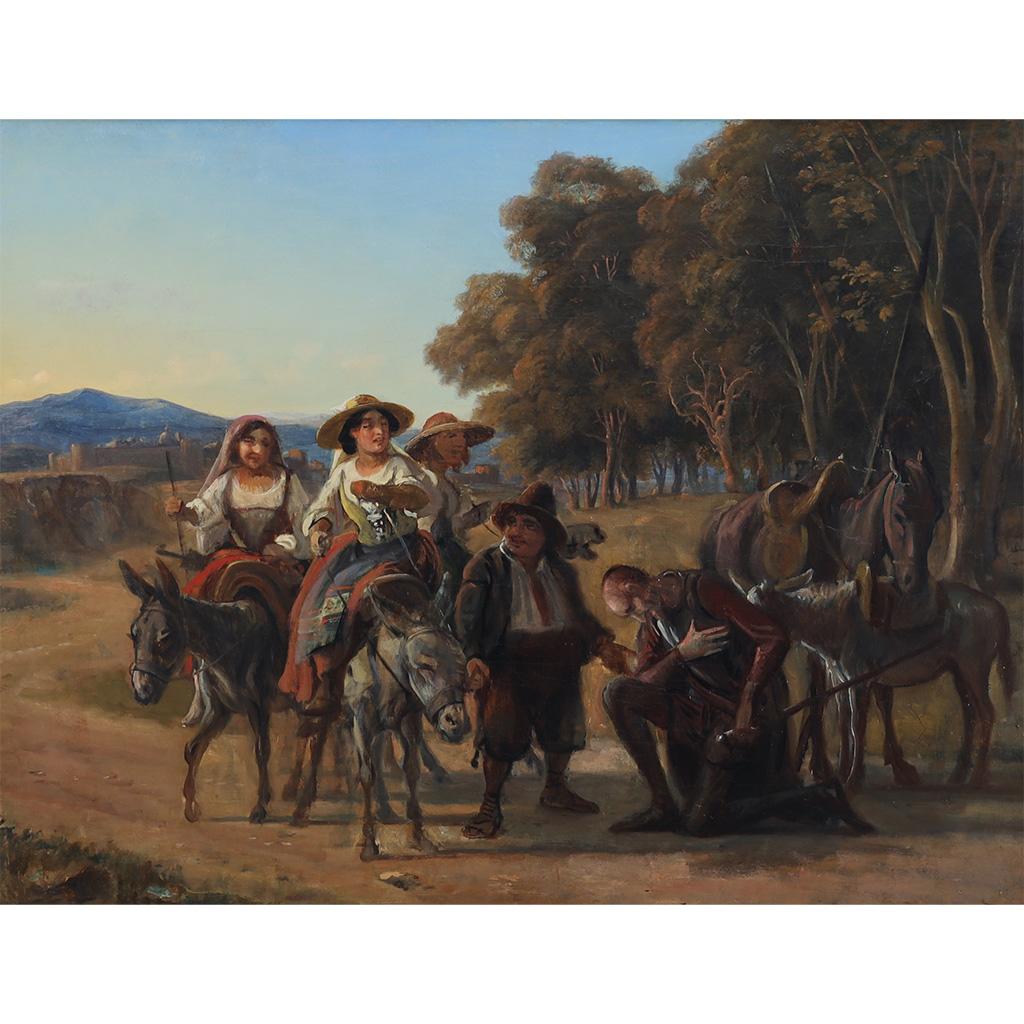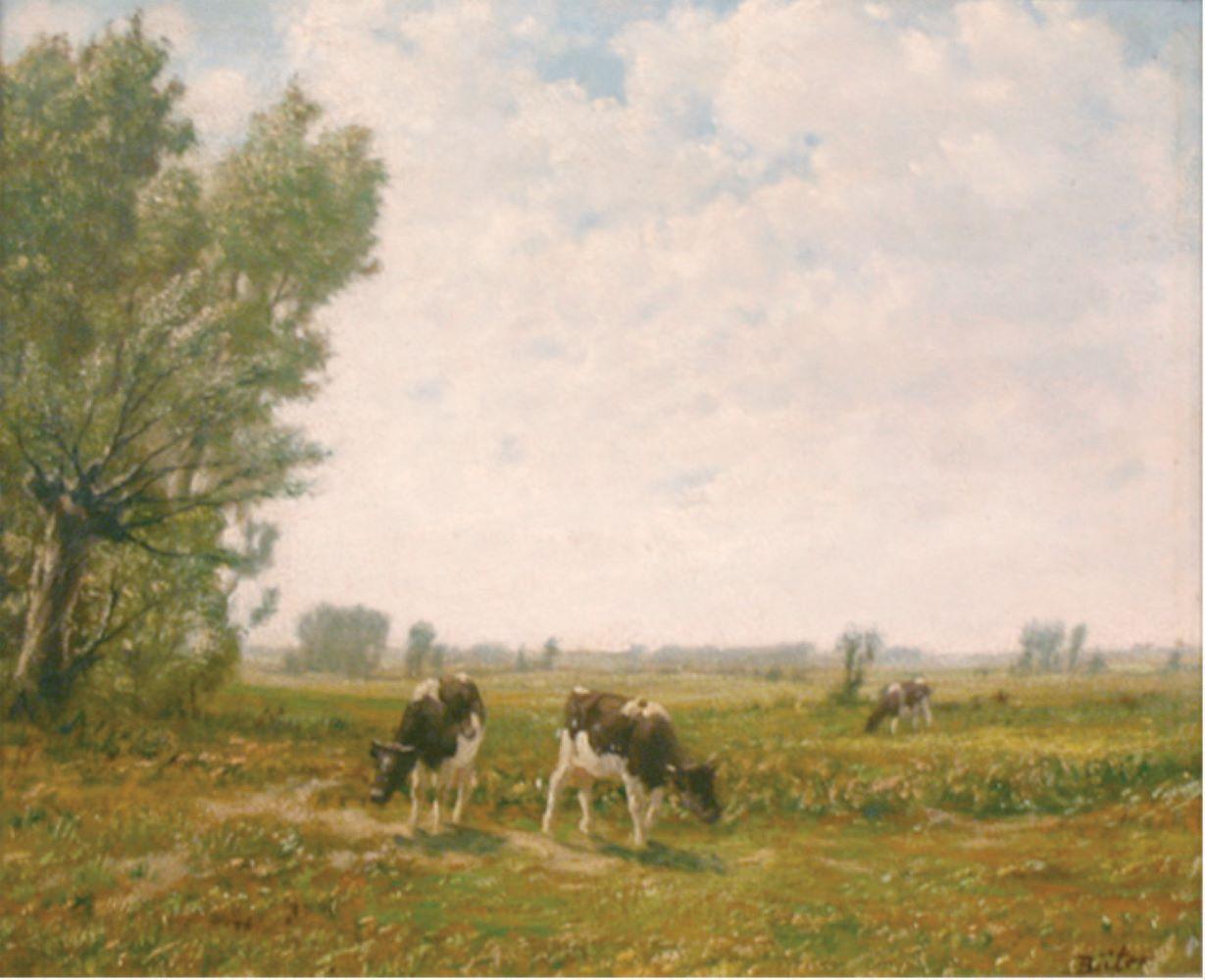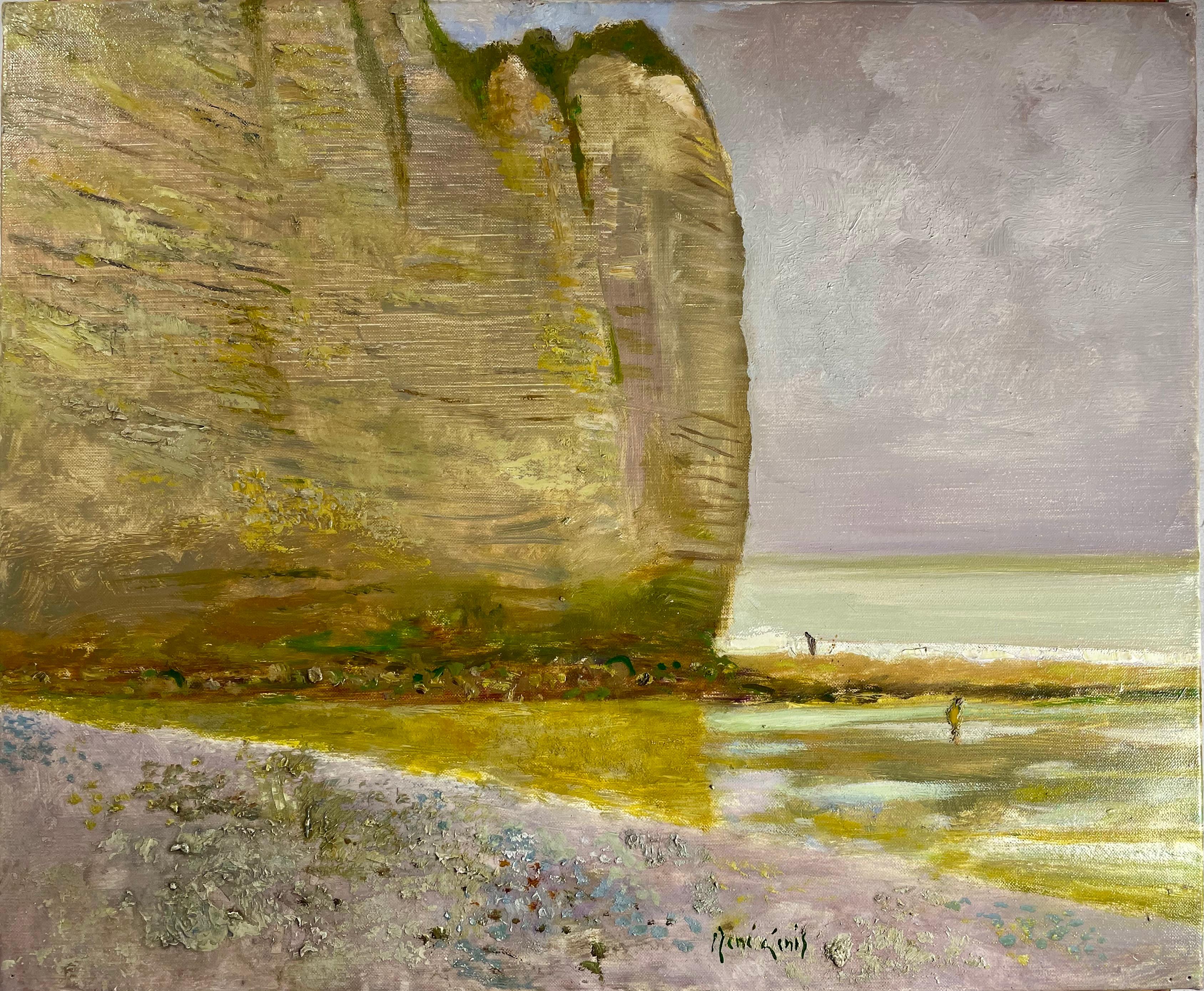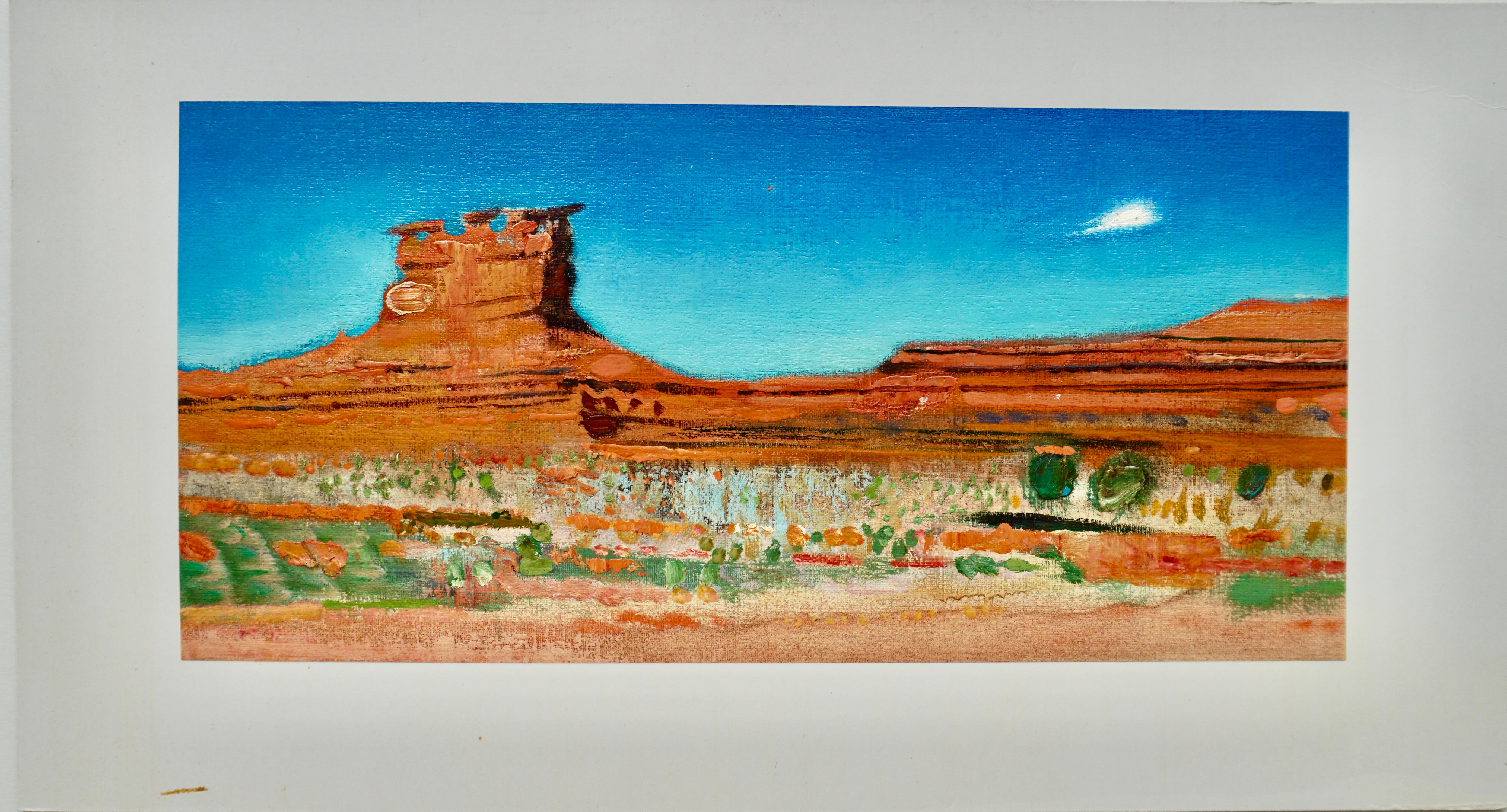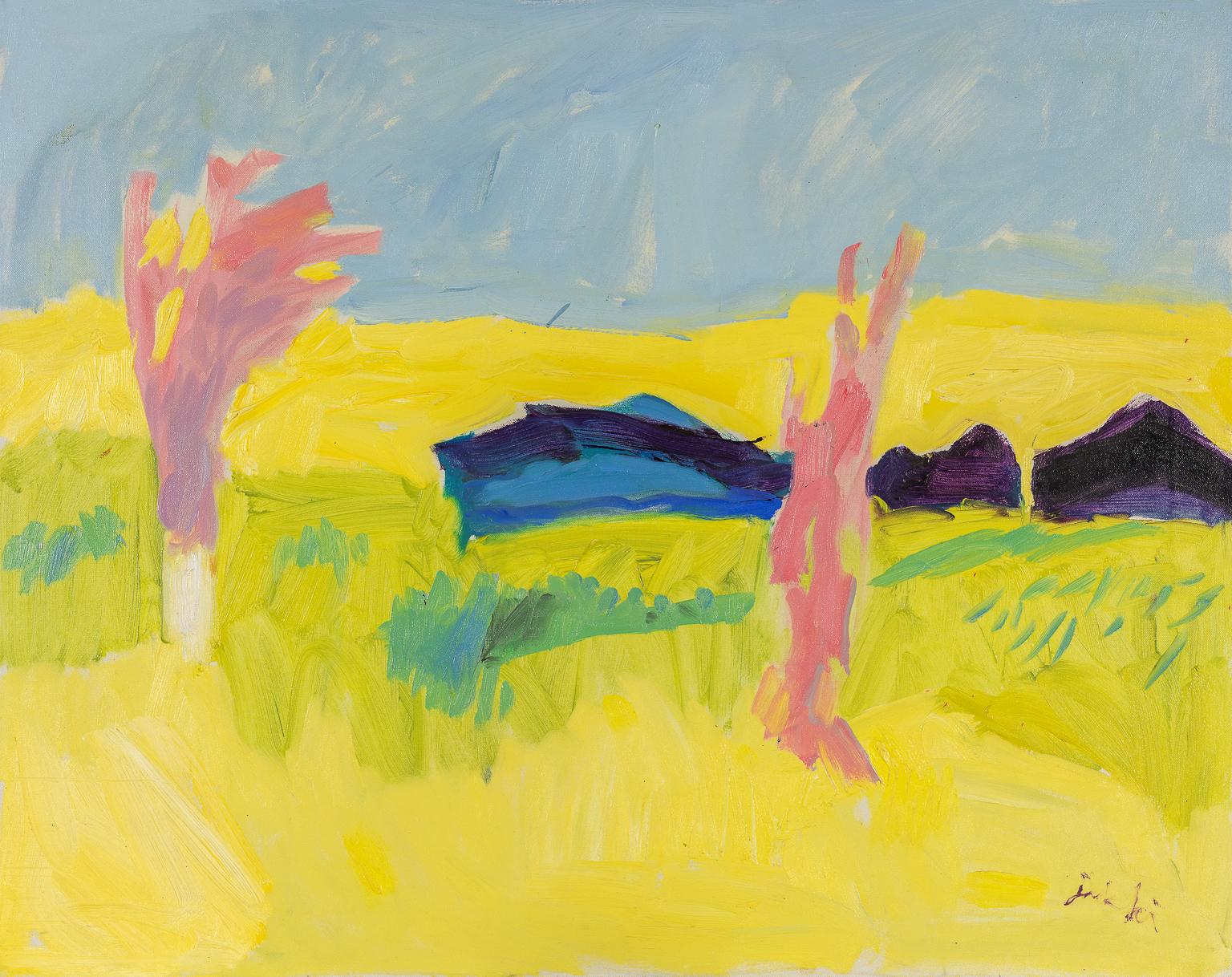Items Similar to "Colossi of Memnon, Egypt" Rare Orientalist Landscape Painting by F.A. Bridgman
Want more images or videos?
Request additional images or videos from the seller
1 of 15
Frederick Arthur Bridgman"Colossi of Memnon, Egypt" Rare Orientalist Landscape Painting by F.A. BridgmanC. 1874
C. 1874
About the Item
"Colossi of Memnon, Egypt" Rare Orientalist Landscape Painting by Frederick Arthur Bridgman (American, 1847-1928)
A wonderful oil on canvas painting by American orientalist painter Frederick Arthur Bridgman depicting The Colossi of Memnon - two large stone statues of Pharaoh Amenhotep III, who reigned in Egypt during the Eighteenth Dynasty of Egypt. The statues are located in Thebes.
This rare work was painted on Bridgman's first trip to the Middle East which span from 1872 - 1874. In the time Bridgman worked mostly "plein air" - painting on the spot. He also executed views of the ruins at Abu Simbel in the same year. This is the only known work from this time that was executed at Thebes. Signed lower right.
Canvas: 12" high x 17" wide
Frame: 18" high x 23" wide
A similar example was sold: Christies 19TH CENTURY EUROPEAN ART AND ORIENTALIST ART, 23 Oct 2007, Lot 80
($97,000)
In very good condition, ready to hang no damages noted. Relined, c. 1950.
Frederick Bridgman started out in 1863 as an engraver for the American Banknote Company and went on to produce steel engravings. He went to Paris in 1866 and worked in Gérome's studio at the École des Beaux-Arts. He spent time in Brittany at Pont-Aven until 1871, before going to North Africa and Egypt in 1872 and remaining there for five years. He took part regularly in the Paris Salons, notably the Salon des Artistes Français and the Salon of the Société Coloniale des Artistes Français. He also exhibited in London at the Royal Academy and the Suffolk Street Gallery. Bridgman exhibited at the Exposition Universelle of 1878, 1889 and 1900, receiving a silver medal at each of the exhibitions. He was decorated with the Légion d'Honneur in 1878 and was made Officier in 1907. He became a member of the National Academy, New York, in 1881, and of the Société des Artistes Peintres, Paris.
Bridgman's travels in North Africa and Egypt brought about a radical change in his palette, which became much paler. He was also a photographer and often worked from his photographs when painting, depicting a world of richly adorned women in veils and using transparent effects and white on white. As well as his scenes of everyday life, Bridgman also painted historical subjects from Ancient Egypt and Assyria, such as Pharaoh Crossing the Red Sea and Royal Entertainment at Nineveh. A cultivated man, Bridgman studied musical composition with Charles-Marie Widor and wrote several books on art. In New York in 1890, he published Winters in Algiers, which he illustrated with his paintings.
- Creator:Frederick Arthur Bridgman (1847 - 1928, American)
- Creation Year:C. 1874
- Dimensions:Height: 18 in (45.72 cm)Width: 23 in (58.42 cm)Depth: 2 in (5.08 cm)
- Medium:
- Period:
- Condition:
- Gallery Location:New York, NY
- Reference Number:1stDibs: LU1151211325592
About the Seller
5.0
Gold Seller
These expertly vetted sellers are highly rated and consistently exceed customer expectations.
Established in 1980
1stDibs seller since 2019
13 sales on 1stDibs
Typical response time: <1 hour
- ShippingRetrieving quote...Ships From: New York, NY
- Return PolicyA return for this item may be initiated within 7 days of delivery.
More From This SellerView All
- Ralph Pallen Coleman (American 1892-1968) A Monumental Painting of Jesus ChristLocated in New York, NYRalph Pallen Coleman (American 1892-1968) A Monumental Painting of "The Resurrection of Jesus Christ", circa 1940. Measuring 102" high x 77" wide (framed), this massive oil on canvas painting is truly one of a kind. The quality throughout the entire painting is masterful. The painting is very realistically painted with bright, vibrant, colors which shows the artists true passion and love for Jesus and Christianity. Ralph Pallen Coleman was an American painter and illustrator. His career spanned more than half a century during which he illustrated stories for many magazines, and later, religious illustrations and paintings which provided images of Christianity to millions of people during the 1950s-1960's. A native of Philadelphia, Pennsylvania, he grew up and lived there throughout his 75 years. He received his formal art education at the Philadelphia School...Category
1940s Portrait Paintings
MaterialsOil, Canvas
- "The Kiosk of Trajan", A Rare Orientalist Landscape Painting by F.A. BridgmanBy Frederick Arthur BridgmanLocated in New York, NY"The Kiosk of Trajan", A Rare Orientalist Landscape Painting by Frederick Arthur Bridgman (American, 1847 - 1928) A stunning oil on can...Category
19th Century Landscape Paintings
MaterialsCanvas, Oil
- Kipp Soldwedel Operation Statue of Liberty Oil PaintingBy Kipp SoldwedelLocated in New York, NYKipp Soldwedel (American 1913-1999) "Operation Liberty" Statue of Liberty Oil on Canvas The artist painted this work for the 100th Anniversary of the Stat...Category
Mid-19th Century Landscape Paintings
MaterialsOil
- Louis Chalon (French, 1866–1940) An Orientalist Landscape of The Golden HornBy Louis ChalonLocated in New York, NYLouis Chalon (French, 1866–1940) An Orientalist Landscape Painting of The Golden Horn, Bosphorus, Istanbul, with views of The Suleymaniye Mosque with the Galata Tower, Constantinople...Category
Early 20th Century Landscape Paintings
MaterialsOil
- Kipp Soldwedel Operation Sail New York Harbor Oil PaintingBy Kipp SoldwedelLocated in New York, NYKipp Soldwedel (American 1913-1999) "Operation Sail" oil on canvas Very rare painting depicting the arrival of all tall ships taking part of the New York Harbor Event in 1964 and Celebrating the Birth of America. Framed with brass nameplates for all the vessels / ships. President John F. Kennedy coined the name for the event. The name 'Operation Sail', was to be used again in 1976, 1989, 1992 & 2000. The painting is a water-level view of the International fleet, USS Forrestal aircraft carrier in background, and Statue of Liberty to the right. This was painted in 1976. Signed lower right. Verso signed, inscribed with artist's copyrights and dedicated lower right. Please note this painting hung in the Rotunda of the Statue of Liberty Monument on Liberty Island, New York Harbor on July 4, 1988. Without frame measuring 48" high by 70" wide. With frame: 58" high x 80" wide Marine artist Kipp Soldwedel studied fine arts at Yale University and was awarded four Beaux Arts medals. He received a scholarship to the American Academy in Rome. During World War II, he was a flight instructor and meteorologist for the United States Air Force. Kipp Soldwedel is most well known for his maritime battle scenes though he did paint over 150 portraits of celebrities. His illustrations appeared in magazines such as National Geographic, Time, Life, and Town and Country. Many of his paintings depicted the tall ships. He was the known as one of the greatest modren masters of Marine Paintings. 1964 The first Operation Sail event, a tie-in with the New York World's Fair, brought tall ships from around the world to New York Harbor for a grand parade of sail up the Hudson, led by the USCGC Eagle as the host ship. Many of the vessels raced from Plymouth, England, to Lisbon, Portugal, before setting off on a 3,000-mile transatlantic journey to Bermuda and then a 630-mile northwest run to New York. The event also featured lifeboat races, a ticker-tape parade up Broadway honoring seamen of every participating nation, and two grand balls. Mayor Robert Wagner proclaimed that week in July to be "Operation Sail Week," and Secretary of...Category
20th Century Landscape Paintings
MaterialsOil
- Reply of the Zaporozhian Cossacks to Sultan Mehmed IV Painting after Ilya RepinLocated in New York, NYReply of the Zaporozhian Cossacks to Sultan Mehmed IV of the Ottoman Empire, also known as Cossacks of Saporog, Are Drafting a Manifesto. Late 19...Category
Late 19th Century Figurative Paintings
MaterialsOil, Canvas
You May Also Like
- Don Quichote and Sacho pansaLocated in Greding, DEWilhelm Marstrand (1810-1873), Don Quichote und Sancho Pansa. Oil on canvas with a very nice frame: 45,5 x 57 cm.Category
19th Century Figurative Paintings
MaterialsCanvas, Oil
- Bernhard ButerLocated in Saint Augustine, FLArtist: Bernhard Buter (1883-1959) German Title: Rhinish Landscape Medium: Oil on Canvas Dimensions: Framed 19” x 21” , Unframed 11 x 13” Bernhard Buter paints agrarian landscapes i...Category
Early 20th Century Realist Landscape Paintings
MaterialsCanvas, Oil
- "Les Falaise Normande" (The Cliffs Of Normand)By René GenisLocated in Berlin, MDRene Genis (French 1922-2004) “Les Falaise Normande” / The Cliffs of Normand. A sea scape with high cliffs, the beach, and two fishermen. The cliffs are in browns, tans and olives a...Category
1990s French School Landscape Paintings
MaterialsCanvas, Oil
- "Monument Valley"By René GenisLocated in Berlin, MDRene Genis (French 1922-2004) Monument Valley. 1967. Beautiful oranges, browns, greens against a turquoise blue sky. Oil on canvas, laid on mat. Si...Category
Mid-20th Century Landscape Paintings
MaterialsOil, Canvas
- Early oil depicting the Great Fire of LondonLocated in London, GBThe Great Fire of London in September 1666 was one of the greatest disasters in the city’s history. The City, with its wooden houses crowded together in narrow streets, was a natural fire risk, and predictions that London would burn down became a shocking reality. The fire began in a bakery in Pudding Lane, an area near the Thames teeming with warehouses and shops full of flammable materials, such as timber, oil, coal, pitch and turpentine. Inevitably the fire spread rapidly from this area into the City. Our painting depicts the impact of the fire on those who were caught in it and creates a very dramatic impression of what the fire was like. Closer inspection reveals a scene of chaos and panic with people running out of the gates. It shows Cripplegate in the north of the City, with St Giles without Cripplegate to its left, in flames (on the site of the present day Barbican). The painting probably represents the fire on the night of Tuesday 4 September, when four-fifths of the City was burning at once, including St Paul's Cathedral. Old St Paul’s can be seen to the right of the canvas, the medieval church with its thick stone walls, was considered a place of safety, but the building was covered in wooden scaffolding as it was in the midst of being restored by the then little known architect, Christopher Wren and caught fire. Our painting seems to depict a specific moment on the Tuesday night when the lead on St Paul’s caught fire and, as the diarist John Evelyn described: ‘the stones of Paul’s flew like grenades, the melting lead running down the streets in a stream and the very pavements glowing with the firey redness, so as no horse, nor man, was able to tread on them.’ Although the loss of life was minimal, some accounts record only sixteen perished, the magnitude of the property loss was shocking – some four hundred and thirty acres, about eighty per cent of the City proper was destroyed, including over thirteen thousand houses, eighty-nine churches, and fifty-two Guild Halls. Thousands were homeless and financially ruined. The Great Fire, and the subsequent fire of 1676, which destroyed over six hundred houses south of the Thames, changed the appearance of London forever. The one constructive outcome of the Great Fire was that the plague, which had devastated the population of London since 1665, diminished greatly, due to the mass death of the plague-carrying rats in the blaze. The fire was widely reported in eyewitness accounts, newspapers, letters and diaries. Samuel Pepys recorded climbing the steeple of Barking Church from which he viewed the destroyed City: ‘the saddest sight of desolation that I ever saw.’ There was an official enquiry into the causes of the fire, petitions to the King and Lord Mayor to rebuild, new legislation and building Acts. Naturally, the fire became a dramatic and extremely popular subject for painters and engravers. A group of works relatively closely related to the present picture have been traditionally ascribed to Jan Griffier...Category
17th Century Old Masters Landscape Paintings
MaterialsOil, Canvas
- I-90, Natick, MassachusettsLocated in Gloucester, MAPeter Lyons’s technique approaches photographic realism, but the precision in his paintings is an attempt to communicate a state of awareness, rather than ...Category
2010s Contemporary Landscape Paintings
MaterialsCanvas, Oil
Recently Viewed
View AllMore Ways To Browse
19th Century Paintings Of New York
Landscape Painting American 19th Century
Large Europe Landscape Painting
Large European Landscape Painting
Large 19th Century Landscape Paintings
Paintings Of North Africa
African Landscape Oil Painting
North African Art Paintings
19th C Landscapes
18 C Landscapes
African Middle East
Rare African Art
19th C Landscape Painting
Relined Paintings
19th Century European Landscape Paintings
Egyptian Stone
Egypt Stone
Large Winter Landscape
